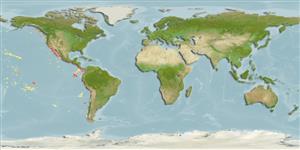Actinopterygii (ray-finned fishes) >
Ophidiiformes (Cusk eels) >
Ophidiidae (Cusk-eels) > Neobythitinae
Etymology: Monomitopus: Greek, monos = one + Greek, mitos, -ou = sting of a lyre + Greek, pous = foot (Ref. 45335). More on author: Garman.
Environment / Climate / Range
Ecology
Marine; bathydemersal; depth range 560 - 1260 m (Ref. 38374). Deep-water, preferred ?
Eastern Pacific: off northern Peru to northern Columbia (J.Nielsen, pers. comm. 05/06).
Size / Weight / Age
Maturity: Lm ? range ? - ? cm
Max length : 22.6 cm SL male/unsexed; (Ref. 38374)
Short description
Morphology | Morphometrics
Dorsal
spines
(total): 0;
Dorsal
soft rays
(total): 92-104;
Anal
spines: 0;
Anal
soft rays: 72 - 86. robust body; eye diameter equal to or slightly shorter than snout; opercular spine strong; preopercle with 2 or 3 more or less distinct spines at lower angle; 1 median basibranchial tooth patch; 1 pelvic fin ray; precaudal vertebrae 13 to 15 (Ref. 34024).
Rare species (Ref. 34024). Reproductive strategy possibly similar to other members of this family featuring oviparity, with oval pelagic eggs floating in a gelatinous mass (Ref. 205).
Life cycle and mating behavior
Maturity | Reproduction | Spawning | Eggs | Fecundity | Larvae
Nielsen, J.G., D.M. Cohen, D.F. Markle and C.R. Robins, 1999. Ophidiiform fishes of the world (Order Ophidiiformes). An annotated and illustrated catalogue of pearlfishes, cusk-eels, brotulas and other ophidiiform fishes known to date. FAO Fish. Synop. 125(18):178p. Rome: FAO. (Ref. 34024)
IUCN Red List Status (Ref. 115185)
CITES (Ref. 94142)
Not Evaluated
Threat to humans
Harmless
Human uses
Fisheries: of no interest
More information
Age/SizeGrowthLength-weightLength-lengthLength-frequenciesMorphometricsMorphologyLarvaeLarval dynamicsRecruitmentAbundance
ReferencesAquacultureAquaculture profileStrainsGeneticsAllele frequenciesHeritabilityDiseasesProcessingMass conversion
Tools
Special reports
Download XML
Internet sources
